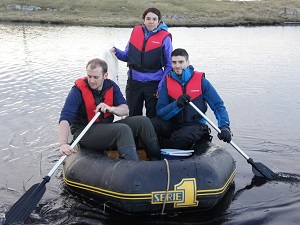






Many of us in the lab use the three-spined stickleback Gasterosteus aculeatus as a model study organism. It is an excellent organism for scientific research in many ways: it is common, widely distributed and phenotypically diverse. It is easy to catch, keep and rear in aquaria. It is small with (for a vertebrate) a short generation time. Last, but certainly not least, it has been genome sequenced.
We work principally on an adaptive radiation of three-spined stickleback in lochs on the island of North Uist in the Scottish Western Isles, but are also involved in collaborations to study sticklebacks in Iceland, British Columbia and Alaska. On North Uist, sticklebacks exhibit a phenomenal diversity of morphological phenotypes. The underlying cause of this diversity is variation in water chemistry, from acid (<pH6) to alkaline (>pH9) and from fresh to hypersaline. However, evolution in at least some traits (e.g. body size) appears to be driven more by ecological variation (competition and predation) related to the water chemistry, than by the water chemistry itself.
 There are also substantial and consistent differences among the lochs in the parasite communities of Uist sticklebacks. The reasons for this are not clear. Water chemistry generally does not account for the differences (although marine parasite communities are different from those in freshwater), but the presence or absence of intermediate hosts may well be important. Resistance of the sticklebacks to parasites also varies substantially between lochs. Fish tend to be less resistant to a particular parasite if it does not occur in their own loch. This strongly suggests that resistance has evolved in different ways in different lochs in response to local parasite communities. Consistent with this, crosses between sticklebacks from different lochs tend to have resistance intermediate to that of their parental populations.
There are also substantial and consistent differences among the lochs in the parasite communities of Uist sticklebacks. The reasons for this are not clear. Water chemistry generally does not account for the differences (although marine parasite communities are different from those in freshwater), but the presence or absence of intermediate hosts may well be important. Resistance of the sticklebacks to parasites also varies substantially between lochs. Fish tend to be less resistant to a particular parasite if it does not occur in their own loch. This strongly suggests that resistance has evolved in different ways in different lochs in response to local parasite communities. Consistent with this, crosses between sticklebacks from different lochs tend to have resistance intermediate to that of their parental populations.
Local adaptation in the sticklebacks, including to parasites, probably makes it difficult for sticklebacks to disperse between populations, and likely contributes to the strong genetic structure among populations. In some of the lochs we see pairs of populations that occur together (sympatrically). These 'resident' and 'anadromous' forms do not interbreed, although breeding takes place at the same time and in the same habitats. This demonstrates that the forms are 'good' species according to the biological species concept. They probably diverged in allopatry following sea-level fluctuations after the last ice age.
Sticklebacks and humans
Sticklebacks were once so numerous in northern Europe that they were spread on fields as fertiliser!
Pennant (1761) recorded that a farmer once charged one of his labourers to sell the sticklebacks that were clogging up his local river. The labourer "earned four shillings a day, though he was paid (only) a halfpenny a bushel". This suggests that the labourer sold approximately 2.5 tonnes of sticklebacks a day!
In the Russian city of Kronstadt there is a sculpture dedicated to the stickleback, because they were an important source of food during a Nazi siege in the Second World War.
Sticklebacks are not generally thought of as edible, but apparently they can be used to make "a good and nourishing fish-soup".
Sticklebacks have appeared on a bank note in the Netherlands, and on a stamp in Iceland.
There are two novels with the title "Stickleback".
The British and American navies have both named submarines "Stickleback".